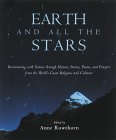
"There is a true yearning to respond to the singing river and the wise rock," as Maya Angelou so eloquently reminded us in her poem entitled "On the Pulse of the Morning". The singing river calls us to sit on her banks and to heed her call to wake up to the beauty of God's creation.
The stinking garbage piled six feet high on Tirana's main street, the foul, polluted air of midtown Manhattan, the clear-cutting of a Brazilian rain forest call us to repentance. The fresh green pastures of Ireland, the purple mountains of Wyoming, the waving Kansas wheat fields, the dove call at dawn, the wind-song of a crisp March day summon us to a new day of love and gratitude, of care and healing for God's creation.
This is the time to wake up to the new day, the time to plant and the time to heal. This is the time to build up and to laugh and to dance. This is the time to sow seeds of health and wholeness. This is the time to embrace and to cherish, the time to look into our brother's eyes and see the vastness of the sea; the time to look on our sister's heart and hear the pulsing rhythm of the universe, to stand in awe before Earth and all the stars.
There is a Buddhist term, mindfulness, which quite simply describes the energy to experience the present, to witness deeply everything that is happening in the current moment. Mindfulness is to be aware and alive to what is going on within and without.
Developing a Theology of Ecology
My thinking has evolved considerably since the first time I taught a new course in ecology and justice at the Hartford Seminary 1991. I began with just two convictions. First, that Christians had a clear mandate to care for God's creation and that there was plenty to support that responsibility in traditional Hebrew and Christian scripture. Thus there was no need to look anywhere beyond Judeo-Christian tradition to develop a theology of ecology. Second, that the examination of the major issues of ecology (pollution of water, land, air and space; population and poverty; the depletion of natural resources; the interaction of military power and environmental degradation; the relationship between the global economy and the environment; environmental racism) would be enough to engender a heightened awareness of a planet in peril and encourage the students to take corrective action.
And so the course met and students diligently researched their assignments as the weeks rolled on. The topics engaged them and, through lively sharing of insights, we all had our consciousness raised. But I also began to notice a slight, unspoken sense of growing frustration. I asked why that should be. "Yes, we can take action," they said. "We can and we will call our senators and members of congress as issues affecting the environment come up on the federal agenda. We can boycott the products of companies who dump their waste irresponsibly and support those with clean records."
They could do all of that and they did. But they wanted more. They wanted to celebrate through prayer and song the wonders of God's creation. They wanted to repent for the ways they and their lifestyles had contributed to the disfiguring of creation. They wanted to offer their concerns for the environment to God. So quite spontaneously, one day, we began singing lines such as "For the beauty of the earth" and "Morning has broken, like the first morning." Later, we wrote our own prayers and adapted others.
We fell into a pattern of devoting the last half hour of every class to some sort of worship built upon the environmental issues we had been examining that day. This was an entirely unexpected but nurturing evolution in the course.
Focusing on the Natural World
As time went on, I collected prayers and readings relating to creation and I continuously searched for more. Visiting a new city or with a few hours to spare, I'd visit the public library. I explored university libraries. At Iona, a small island off the west coast of Scotland, I got in touch with my Celtic roots while pursuing my goal. The Celtic Christianity of the second and third centuries speaks with uncanny clarity to those of us poised on the edge of the third millennium.
Missionaries did not eradicate the indigenous religious rites -- so focused on the natural world -- that they found in these windswept lands. Rather, they built Christianity onto the pagan foundations. The result is a pleasing wedding of traditions. Celtic Christianity thus opens to us a view of the cosmic sense of God's presence throughout all of creation; in the land, the rocks, the mountains and hills. God in the waters and in the eye of the storm, God in and through, under and over, every thing and being in the universe. It is no accident that Ireland's earliest recorded poem, written one hundred years before the birth of Christ, begins "I am the wind ...."
The Goodness of Creation is a Universal Experience
 Then I took my first trip to Japan. In Kyoto alone there are some two thousand Shinto and Buddhist temples or shrines. They are literally everywhere -- in residential neighborhoods, on street corners and commercial areas, in markets, along roadways, and in places of natural beauty. I got a powerful sense of the holy in Japan.
Then I took my first trip to Japan. In Kyoto alone there are some two thousand Shinto and Buddhist temples or shrines. They are literally everywhere -- in residential neighborhoods, on street corners and commercial areas, in markets, along roadways, and in places of natural beauty. I got a powerful sense of the holy in Japan.
This impression clashed sharply with my expectations of high-tech, super-power Japan which, along with the United States, is one of the world's worst despoilers of the environment. There is another Japan that I was privileged to discover. This is the Japan of high, lush mountains, crashing waterfalls and clear streams; the Japan of cool bamboo forests and luscious tiers of verdant rice paddies. Here true holiness is to be found. This holiness, felt walking through the Kurama Temple in Kyoto, convinced me that my sights had been far too narrow in collecting only Christian sources.
It was a chilly but sunny day during the Golden Week Festival and, with my companions, I had taken a little wooden train up to the foot of Kurama Mountain. We walked through the pretty village of Kurama, over the stream, and through the giant vermilion torii where the temple path begins. A Japanese temple is more than buildings; it is woods, gardens, ponds, waterfalls, and streams. It is giant gongs, incense, candles, and prayer boards. It covers anything from a city block to an entire mountain, and may be a mix of Buddhist and Shinto artifacts. As we climbed Kurama Mountain, we passed the shrines, some with incense burners, others with water slowly dripping into cool stone basins.
At the main temple building I came across an explanation...in which the spirit of the moon is understood as love, the spirit of the sun as light, and the spirit of the earth as power. As I continued my walk down the back side of Kurama through the bamboo forest, I knew that I had literally had a mountain-top experience. A door had been opened, and before me lay a treasure trove. I was filled with an insatiable desire to discover the wealth of readings affirming the goodness of creation from other traditions of the world to add to the Christian sources. Through them I had an inkling that my Christianity would continue to deepen and that I might arrive at a more global sense of wonder at what God -- the God of a thousand names and faces -- is doing to call the people of the earth to honor, cherish, restore, and protect this fragile planet.
Every Living Being Has A Song
A splendid path had been set out for me. I have discovered many treasures in the National Library at the Georges Pompidou Center in Paris. I was drawn to the ancient Hindu vedas, composed sometime between 3000 and 2000 B.C.E., poems of wonder and praise celebrating the gifts of nature and humankind's relationship to the natural world. I studied the Tao Te Ching, written some twenty-five hundred years ago by Lao Tzu. We know almost nothing about this poet, yet he expresses in stark simplicity the idea that human beings are to fit into and blend with creation and not the reverse.
While these works were not new to me, I read them with a new depth of understanding. I also identified a number of ancient and modern literary treasures from Japan, Korea, the Philippines and especially the Chinese landscape poetry of the Tang and Sung Dynasties (618 to 960 B.C.E. and 960 to 1127 B.C.E.). Tang and Sung poets display a range and richness of expression. They were grounded in the belief that knowing the position of the human being in the totality of the universe is the height of wisdom.
The contemporary Japanese author Ki no Tsurayuki said, "When we hear the warbling of the mountain thrush in the blossoms or the voice of the frog in the water, we know every living being has a song." It is a song of the ten million sounds of the earth and all the stars.
The Christian theologian David Tracy said "there is a new form of spiritual journey, new for Christianity and for all the traditions.... The new search is likely to become that of more and more religious persons. Stay faithful to your own tradition; go more and more deeply into its particularities; defend and clarify its identity. At the same time, wander Ulysses-like, willingly, even eagerly, among other great traditions and ways; try to learn something of their beauty and truth; concentrate on their otherness and difference as the new route to communicality."
Reprinted with permission of the publisher,
New World Library, Novato, California, USA, 94949.
©2000. www.newworldlibrary.com
Article Source
Earth and All the Stars : Reconnecting with Nature through Hymns, Stories, Poems, and Prayers from the World's Great Religions and Cultures
by Anne Rowthorn.
 Drawing upon the religions of indigenous people, editor Anne Rowthorn has assembled an elegant anthology for readers who find their God in the natural world. Page by page, prayer by prayer, word by word, these profound pieces of writing offer lifelong companionship for all who believe that God and nature are one and the same.
Drawing upon the religions of indigenous people, editor Anne Rowthorn has assembled an elegant anthology for readers who find their God in the natural world. Page by page, prayer by prayer, word by word, these profound pieces of writing offer lifelong companionship for all who believe that God and nature are one and the same.
Info/Order this book.
About The Author
 Anne Rowthorn is a passionate environmentalist who has spent most of her life working for causes that promote peace and justice on this planet. She is the author of five books, including Caring for Creation.
Anne Rowthorn is a passionate environmentalist who has spent most of her life working for causes that promote peace and justice on this planet. She is the author of five books, including Caring for Creation.























